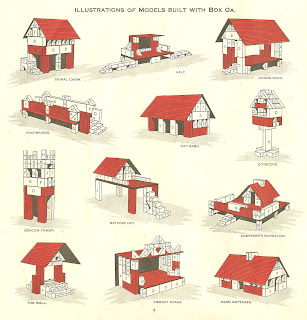Lott's Bricks were an English toy, apparently manufactured from 1918 through the 1960s, notwithstanding a 1911 copyright date prominently appearing on boxes and manuals throughout their existence! One story is, Lott's took over the British operations of Ankerstein manufacturer A. Richter during World War I. But the blocks are not Anchor Blocks - the composition is noticeably different and the size is slightly larger - based on an imperial inch of 25.4 mm versus a metric inch of 25 mm.
 In some ways, I like the Lott's material - slightly slicker & apparently sturdier than Richter's - the pieces are in much better condition than older Richter's tend to be, in spite of obvious signs of having been played with. But I miss the characteristic linseed odor of Richter's, and am inclined to believe that the latter's rougher surface makes for sturdier large constructions. [addendum - I may not have noticed the linseed oil scent on the bricks, but after spending some time handling the Lott's manual, I notice the scent on my fingers!]
In some ways, I like the Lott's material - slightly slicker & apparently sturdier than Richter's - the pieces are in much better condition than older Richter's tend to be, in spite of obvious signs of having been played with. But I miss the characteristic linseed odor of Richter's, and am inclined to believe that the latter's rougher surface makes for sturdier large constructions. [addendum - I may not have noticed the linseed oil scent on the bricks, but after spending some time handling the Lott's manual, I notice the scent on my fingers!]I didn't get the Lott's set for large constructions though, but rather for the charming smaller constructions - in fact, my primary interest in buying the set was the manual not the blocks! The booklet with my #1 set includes plans for sets O, OA, 1, 1A, and 2 - and the parts in set #1 will build any of the O or OA plans, as well as the set 1 plans. There is a lot of nice contrast to the typical Anker constructions.
 This "goods shed," or railway freight house is from the OA plans, all of which are shown on the illustration page, though I have only included one of three pages of plans - be sure to click on these images to see the full size scans, especially the illustration sheet is a pleasure to behold. (I will share additional pages in the future.)
This "goods shed," or railway freight house is from the OA plans, all of which are shown on the illustration page, though I have only included one of three pages of plans - be sure to click on these images to see the full size scans, especially the illustration sheet is a pleasure to behold. (I will share additional pages in the future.)All of the blocks correspond to shapes in Richter sets except for the chimney base which is used here as the middle support under the loading platform. There should be two in the OA and #1 sets, and of course one of these was the only piece broken - with one of the broken halves missing! [Attention Lott's collectors: Anyone have a spare?]
I am contemplating supplementing my unit blocks with some homemade pieces to be able to build the Lott's designs large, in wood.
Even if I do, I expect my Lott's set will be getting quite a bit of use, and delivering quite a bit of pleasure.
Lott's Bricks are classic Good Block Play.











